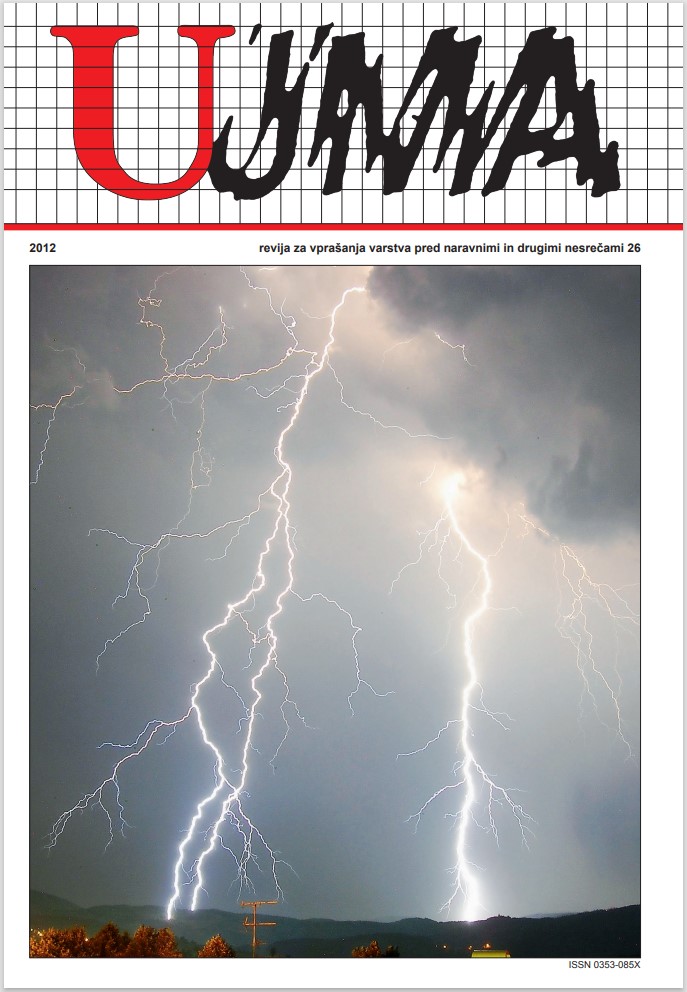EARTHQUAKE INSTRUMENTAL INTENSITY
Abstract
Instrumental intensity is calculated from the largest amplitudes recorded at seismic stations. As data transmission between seismic stations and the processing centre is conducted in real time, information on earthquake effects is obtained almost immediately after the event. However, such assessment requires a dense network of seismic instruments and a mathematical relation linking the macroseismic earthquake intensity with data on seismic ground motion. Such systems are already in operation in urban areas with a dense network of instruments, such as some parts of the U.S.A. and Japan.
References
Cecić, I., Živčić, M., Jesenko, T., Kolar, J., 2005. Potresi v Sloveniji leta 2004, Potresi v letu 2004, ARSO, Ljubljana.
Freeman, A. S., Irfanoglu, A., Paret, F. T., 2004. Earthquake Engineering Intensity Scale: a template with many uses. 13th World Conference on Earthquake Engineering Vancouver, B. C., Canada August 1-6, 2004, Paper No. 1667.
Gosar, A., 2007. Raziskave vpliva lokalne geološke zgradbe na potresno nihanje tal in ranljivosti objektov z mikrotremorji, Geologija 50/1, 65–76, Ljubljana, 2007; Geologija 50/1, 65–76, Ljubljana, 2007.
Grünthal, G. (Editor), 1998. European macroseismic scale 1998, Cahiers du Centre Européen de Géodynamique et de Séismologie, Vol. 15, Luxembourg, 1–99.
Lapajne, K. J., Šket Motnikar, B., Zupančič, P., 2001. Karta potresne nevarnosti Slovenije, MOP – Agencija RS za okolje, Urad za seizmologijo, Dunajska 47/VII, 1000 Ljubljana, http://www.arso.gov.si/potresi/podatki/tolmac_pospeska_tal.html (dostopano 30. 3. 2012).
USGS, 2009. Shakemap atlas, Michoacan, Mexico, 1985; U. S. Department of the Interior | U. S. Geological Survey, http://earthquake.usgs.gov/earthquakes/shakemap/atlas/shake/198509191317 (dostopano 30. 3. 2012).
USGS, 2010. Historic Earthquakes, Michoacan, Mexico, 1985; U. S. Department of the Interior | U. S. Geological Survey, http://earthquake.usgs.gov/earthquakes/world/events/1985_09_19.php (dostopano 30. 3. 2012).
USGS, 2011. Shakemap atlas, Newhall, CA 2011; U. S. Department of the Interior | U. S. Geological Survey, http://earthquake.usgs.gov/earthquakes/shakemap/sc/shake/11001205/ (dostopano 30. 3. 2012).
Vidrih, R., 1983. Poročilo o potresu dne 10. 10. 1982 na ilirsko-bistriškem področju, Seizmološki zavod RS Slovenije, Ljubljana, Interno poročilo.
Vidrih, R., 2008. Potresna dejavnost zgornjega Posočja. Ministrstvo za okolje in prostor, Agencija Republike Slovenije za okolje, Urad za seizmologijo in geologijo, 509 p., Ljubljana.
Wald, J. D., Quitoriano, V., Heaton, H. T., Kanamori, H., 1999. Relationships between Peak Ground Acceleration, Peak Ground Velocity and Modified Intensity in California, Earthquake Spectra 15, pp. 557–564 (1999); doi:10.1193/1.1586058.
Zupančič, P., Šket, M. B., Gosar, A., Prosen, T., 2003. Karta potresne mikrorajonizacije Mestne občine Slovenije, MOP – Agencija RS za okolje, Urad za seizmologijo, Dunajska 47/VII, 1000 Ljubljana, 2003, http://www.arso.gov.si/potresi/potresna%20ne varnost/karta_mikrorajonizacije_lj.html (dostopano 30. 3. 2012).
Downloads
Published
Issue
Section
License

This work is licensed under a Creative Commons Attribution-NonCommercial-NoDerivatives 4.0 International License.
The articles are made available to the public under Creative Commons Attribution-NonCommercial-NoDerivatives 4.0 International (CC BY-NC-ND 4.0).


